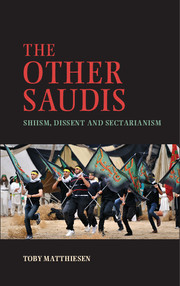Book contents
- Frontmatter
- Dedication
- Contents
- List of Maps and Pictures
- Acknowledgements
- A Note on Conventions
- Glossary
- Abbreviations
- Map
- Introduction
- 1 Politics of Notables
- 2 Oil and Dissent
- 3 Shia Islamism
- 4 A Decade of Confrontation
- 5 No More Revolution
- 6 Marginal Recognition
- 7 A New Intifada
- Conclusion The Politics of Sectarianism
- Bibliography
- Index
- References
3 - Shia Islamism
Published online by Cambridge University Press: 05 December 2014
- Frontmatter
- Dedication
- Contents
- List of Maps and Pictures
- Acknowledgements
- A Note on Conventions
- Glossary
- Abbreviations
- Map
- Introduction
- 1 Politics of Notables
- 2 Oil and Dissent
- 3 Shia Islamism
- 4 A Decade of Confrontation
- 5 No More Revolution
- 6 Marginal Recognition
- 7 A New Intifada
- Conclusion The Politics of Sectarianism
- Bibliography
- Index
- References
Summary
A religious book had as much worth as a rifle. A cassette tape equaled the shot of a pistol. A mourning ceremony for Hussayn was tantamount to a whole opposition corps. Maybe it was then that Qatif learned how to be on permanent alert, always ready, always closed and incomprehensible to strangers. … I have searched, but I have not found anyone writing any histories of Qatif for that period. Perhaps it was all an affair about which we were better off keeping quiet.
Seba al-Herz – The OthersIn the 1950s and 1960s, while the oil workers at ARAMCO went on strike and the first leftist activists moved underground, Shia political and religious discourse in the Iraqi shrine cities was profoundly transformed. Some clerics of the Qatifi notable families such as ʿAbdallah al-Khunayzi were studying in Najaf. They were following the line of the mainstream Najafi marajiʿ such as Muhsin al-Hakim and Abu al-Qasim al-Khuʾi and advocated a religious role for the clergy rather than a political one. Other Saudi Shia clerics were at the forefront of the emerging Shia political parties in Iraq. Muhammad Baqir al-Shakhs (1315–81, 1897/8–1961/2) from al-Ahsa, for example, was a founder of the Society of ʿUlamaʾ (jamaʿat al-ʿulamaʾ) in Najaf in 1959/60. This was an early group of politically minded clerics who sought to counter secularism and constituted a nucleus for Iraqi Shia Islamist parties. Another cleric, who was originally from al-Ahsa, ʿAbd al-Hadi al-Fadli, was also active in the society, published and edited its main publication, and cofounded the Islamic al-Daʿwa Party (hizb al-daʿwa al-islamiyya: hereafter al-daʿwa) in Iraq. Some Saudi students were drawn into al-daʿwa and went back to Saudi Arabia. Yet, unlike amongst other Gulf Shia in Kuwait and Bahrain, al-daʿwa did not become very important in the Saudi context and membership remained limited to some prominent individuals.
- Type
- Chapter
- Information
- The Other SaudisShiism, Dissent and Sectarianism, pp. 91 - 113Publisher: Cambridge University PressPrint publication year: 2014

